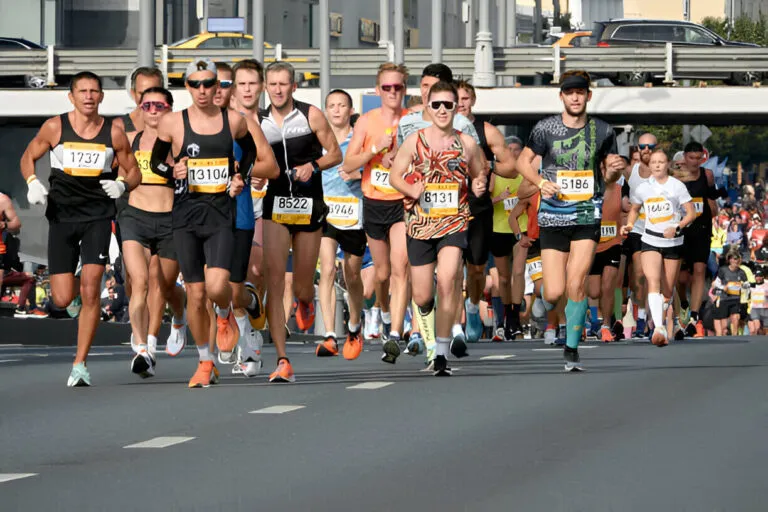Recently updated on June 10th, 2025
Marathon planning is a complicated process that calls for careful preparation, strategic coordination, and cooperation from many different kinds of stakeholders. A marathon is more than just a race; it’s a big public event that encourages community pride, improves health, and frequently boosts local businesses or philanthropic initiatives. Whether held in a picturesque rural setting or a busy city, a successful marathon requires close consideration of participant experience, marketing, safety, and logistics.
With the right preparation and execution, marathon can be an effective platform for good influence, social interaction, and physical accomplishment. This article explains how to organize a marathon event.
How To Organise Marathon Event
To guarantee a successful and safe race experience, marathon event planning entails extensive preparation, organisation, and community involvement. Now let’s learn how to organise marathon event:
Before the Marathon
Step #1: Make a decision regarding the marathon’s primary goal.
After deciding which organization, cause, or charity to support, give the event a name that is memorable and descriptive. Make sure to get in touch with the group you are hosting the event to find out if there are any rules you must follow.
Step #2: Decide on a venue and date for your event.
Having a few backup dates or backup venues in mind could be necessary if the venue is well-liked. Keep an eye out for any potential roadblocks, difficulties, or safety risks and make appropriate plans.
Step #3: Create an event budget plan.
Investigate comparable events to ascertain the approximate expenses of different activities that can be incorporated into your event. Find out how much your event will cost and how it will be funded. Determine the amount of money you need to raise and look into possible fundraising avenues. You should also estimate the amount you hope to raise from each of these sources.
Step #4: Find out what licenses and other permissions you will need.
Before the event, make sure you have enough insurance coverage and find out what kind of liability and/or medical insurance you will require. You might have to get in touch with the parks and recreation department, public works, private property owners, and the local police and fire department.
Step #5: Market and advertise your event.
To get the word out, use flyers, posters, signage, pamphlets, word-of-mouth, and press releases. Make the most of social media by generating interest in your marathon networking websites. It might even be a good idea to create a website or blog to promote your event and keep supporters informed.
Step #6: Get the supplies you’ll need for the event.
These include cups, participant numbers, trash cans or bags, t-shirts, and refreshments (especially bottled water for a run or walk). Keep in mind to give out prizes to your victors, and you might also wish to give your volunteers a small token of appreciation.
Day Of The Marathon
Step #7: Make a checklist of everything that has to be done on the day of the event.
Assign volunteers to each task and ensure that everyone is aware of their responsibilities throughout the event.
Step #8: Before the event starts, arrange all of the materials that will be distributed and have them prepared for participant handouts.
Step #9: Talk to the police or other officials who will be there about any last-minute details.
Step #10: Make plans to attend as early as you can and practice the course.
Ensure that there aren’t any unforeseen modifications, potential safety risks, barriers, or other elements that could affect the race.
After The Marathon
Step #11: Make the site look cleaner.
Make sure to leave it in the same state as when you found it.
Step #12: Write thank-you notes to volunteers and sponsors.
Express your gratitude to volunteers, sponsors, and participants in public using the same social media platforms and a local news release or article.
Step #13: Determine how much money was raised overall (after deducting expenditure) and give it to charity.
Tips On How To Organise Marathon Event
Plan Ahead Of Time
Start at least six to twelve months ahead of time. To prevent clashes with other events or road closures, get your route and permits as soon as possible.
Engage Stakeholders Straightaway
Early planning should involve community leaders, law enforcement, local government, and medical services. Maintain regular and transparent communication to foster support and trust.
Make The Appropriate Decision
Make sure the course is certified (if required for competitive runners), safe, and picturesque. Unless required and authorized, stay away from routes that significantly disturb traffic or business sectors.
Smartly Secure Sponsorships
Provide sponsorship packages that are tier-based (Gold, Silver, Bronze). Point up the advantages of sponsors, like booth space, social media visibility, and logo placements. Reach out to banks, gyms, local companies, and health brands.
Make A Comfort And Safety Plan For Runners
Place hydration stations every two to three kilometers. Provide restrooms along the route and at the beginning and end. Have mobile EMT staff and medical tents on display.
Create A Reliable Volunteer Staff
The event’s volunteers are its foundation. Give everyone a defined role, such as marshals, registration, cleanup, and hydration. Teach them and express gratitude (e.g., post-race celebrations, certificates, T-shirts).
Make Use Of Reliable Timing & Registration Tools
Choose a reliable platform for race registration. Invest in chip timing for competitive events to ensure accuracy and legitimacy.
Consider Yourself A Runner
Make sure there are appropriate start/finish zones, friendly marshals, and clear signs. Provide recovery refreshments, a cool-down space, and a baggage drop spot.
Promote Creatively And Clearly
Make use of a landing page or dedicated website. Advertise using email campaigns, posters, local news, and social media.
Don’t Leave Any Traces
Adopt environmentally friendly practices such as trash segregation, digital waivers, and recyclable water cups. To keep a positive reputation with the community, clean up completely after the event.
Post-Event Follow-Up
Send volunteers, sponsors, and participants a thank-you email. Post images, highlights, and race results to social media. Gather input via surveys to make the race better the following year.
Conclusion
Marathon planning is a complex process that requires careful preparation, teamwork, and close attention to detail. For this reason, knowing and comprehending how to organise marathon event is crucial. Every stage, from choosing a picturesque and safe route to organizing volunteers and obtaining sponsorships, adds to the event’s ultimate success.
A well-run marathon encourages community involvement, physical fitness, and the achievement of promotional or charitable objectives. The safety and satisfaction of participants should always come first. For operations to run smoothly, effective communication with all parties involved—including local authorities and medical teams, is crucial. Feedback and post-event analysis are important for enhancing subsequent races and establishing trust over time. In the end, runners, spectators, and the host community all have favorable, long-lasting impressions from a well-run marathon.

